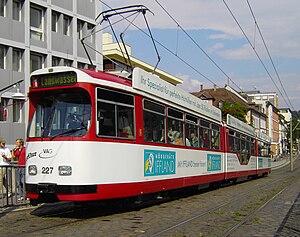This article may require copy editing for grammar, style, cohesion, tone, or spelling. (December 2023) |
The Duewag GT8 Typ Freiburg is a three-part eight-axle articulated tram used on Freiburg im Breisgau's tram network. From 1971 to 1991, these trams were exclusively produced for the Freiburger Verkehrs by the Düsseldorfer Waggonfabrik in three series, which is why they are defined as the Freiburg type, Typ Freiburg. They are designed to be used uni-directionally.
| GT8 | |
|---|---|
 | |
| Manufacturer | Duewag |
| Constructed |
|
| Number built | 25 |
| Fleet numbers |
|
| Specifications | |
| Train length | 32.845 m (107 ft 9 in) |
| Width |
|
| Maximum speed |
|
| Weight |
|
| Power output |
|
| Electric system(s) |
|
| AAR wheel arrangement | B′+B′+B′+B′ |
| Track gauge | 1,000 mm (3 ft 3+3⁄8 in) |
Construction
editTrams with Jacobs bogies were not suitable for the partially narrow, curved radii in Freiburg, so a new type of tram was created. Freiburg's trams were based on the classic 1956 Duewag articulated tram. In contrast to conventional articulated trams, the centre of gravity of Freiburg's trams was not located at the Jacobs bogies but underneath the middle section, to which two tram end parts were attached. In addition to the all-axle drive, a better structure gauge was also used, totaling 34 metres (112 ft) of length.
After the twelve-axle tram was manufactured by the Rhein-Haardtbahn company, Freiburg's trams were regarded as the second longest tram car in the world.
Series
editFirst Series (1971/72)
editBetween the years of 1971 and 1972, the Freiburger Verkehrs AG initially obtained four vehicles using so-called Geamatic controls. They were given the operating numbers 201–204. Carriage 202 (externally distinguishable by its central double headlight) was the first to receive an automatic set point adjuster. They were designed for travel without conductors and to replace some of the obsolete and personnel-intensive vehicle-type sidecars from the early 1950s which were still based on the War Tram Cars.
The trams were originally equipped with a headlight and cream lacquer. During the mid-1980s, they had two headlights installed, which were fitted to the central part. They were repainted red and white in 1981.
In 2001, the trams were decommissioned for use in Freiburg. They were later used across Łódź's tram network, where they were served by Międzygminna Komunikacja Tramwajowa on line 46 to Ozorków. Trams 2-4 were later scrapped during this period.
Second Series (1981/82)
editAfter good experiences with the first four trams, a decision was made to expand the network. Ten more trams were ordered towards the end of the 1970s. These were commissioned in 1981 and 1982 and were given the numbers 205–214, also referred to as GT8K. They were lacquered in red and white and had two central front headlights. On journeys, there was no need for a conductor, and the last type of tram with sidecars were discarded.
At a length of 2.32 metres, they are twelve centimetres wider than the trams from the first series, which, in some curves of the network, required new tracks to be laid. An example of this was at the Schwabentor. The larger width made it possible to make trams slightly bigger than the first series. Both storeys across the two series were very high, but were now accessible in the second series by means of three normal steps. The seats were also laid out 1+2, enabling more standing passengers to board the tram.
Instead of the mechanics of the first series, the second series used a direct current controller, which was operated via a set point transmitter. It enabled acceleration and deceleration to take place without jerking. In comparison to the first series, which had scissor pantographs, the second series used single-armed pantographs.
Tram 205 is now used as an historic motor coach; tram 207 was scrapped in 2007; and trams 208 and 209 were sold to Ulm's tram network, where they were merged to form tram number 17 and used as a bi-directional rail grinder. From 2012, trams 206 and 210-214 were used full-time due to the refurbishment of the GT8Zs. Previously, they were only used during peak hours and for transporting spectators to SC Freiburg home matches. Tram 206, which had already been marketed for sale, was now reactivated. In addition, they were all equipped with LED indicators. They are the only trams, alongside the Combinos, to have fitted LED indicators. The remaining trams were still being used until the completion of the GT8Z refurbishment and the delivery of the new CAF Urbos in 2017.
Third Series (1990/91)
editIn 1990 and 1991, a further eleven motorised trams were obtained with numbers 221 to 231. In contrast to the second series, they were equipped with a low-floor middle section. Because of their low leverage, they are also referred to as GT8N. Otherwise, they differ from their predecessor series by means of shear current pickups. They replaced the GT4, now used in Stuttgart, in the short term. All vehicles in this series were fitted with a dot-matrix display in 2001 and run on lines 1, 3 and 5.
Further reading
edit- Dietmar Gemander/Thomas Hettinger: Freiburger Straßenbahn - Die Zeit vor der Stadtbahn; Freiburg, 2006